Bonus Material: Linkable Asset Swipe File
In 12 months, my content distribution team increased organic traffic to a software company's site by 706.42% by promoting four old blog posts. This organic traffic then turned into $1,433,458 of new sales pipeline:

It’s kinda hard to see, but the breakdown (by stage of sales pipeline) was:
- New sales opportunities: $300,400
- Trials: $125,000
- Proposals sent: $165,325
- Negotiation: $10,000
- Closed won: $564,333
- Closed lost: $268,400
In this post I’m going to show you exactly how we did it.
Step-by-step.
First, grab the list of four blog posts we promoted below to see what type of blog posts you need, and what topics they were on.
Then read on to see how we promoted them using the “linkable asset” strategy.
The "Linkable Asset" Strategy
As you know, "content saturation" is at an all-time high now.
With 4,800 blog posts published every minute it almost seems impossible to stand out.
You’ve probably felt the shift...
- 90.63% of content gets no traffic from Google
- The average content marketing article attracts 4 social shares
- 70+% of articles never get a single backlink
- The average person's attention span is 8 seconds
- Ad click prices are unpredictable
That’s why if you want to scale your organic traffic, you need a simple and replicable strategy that doesn't rely on creating lots of new content.
Enter:
The Linkable Asset strategy.
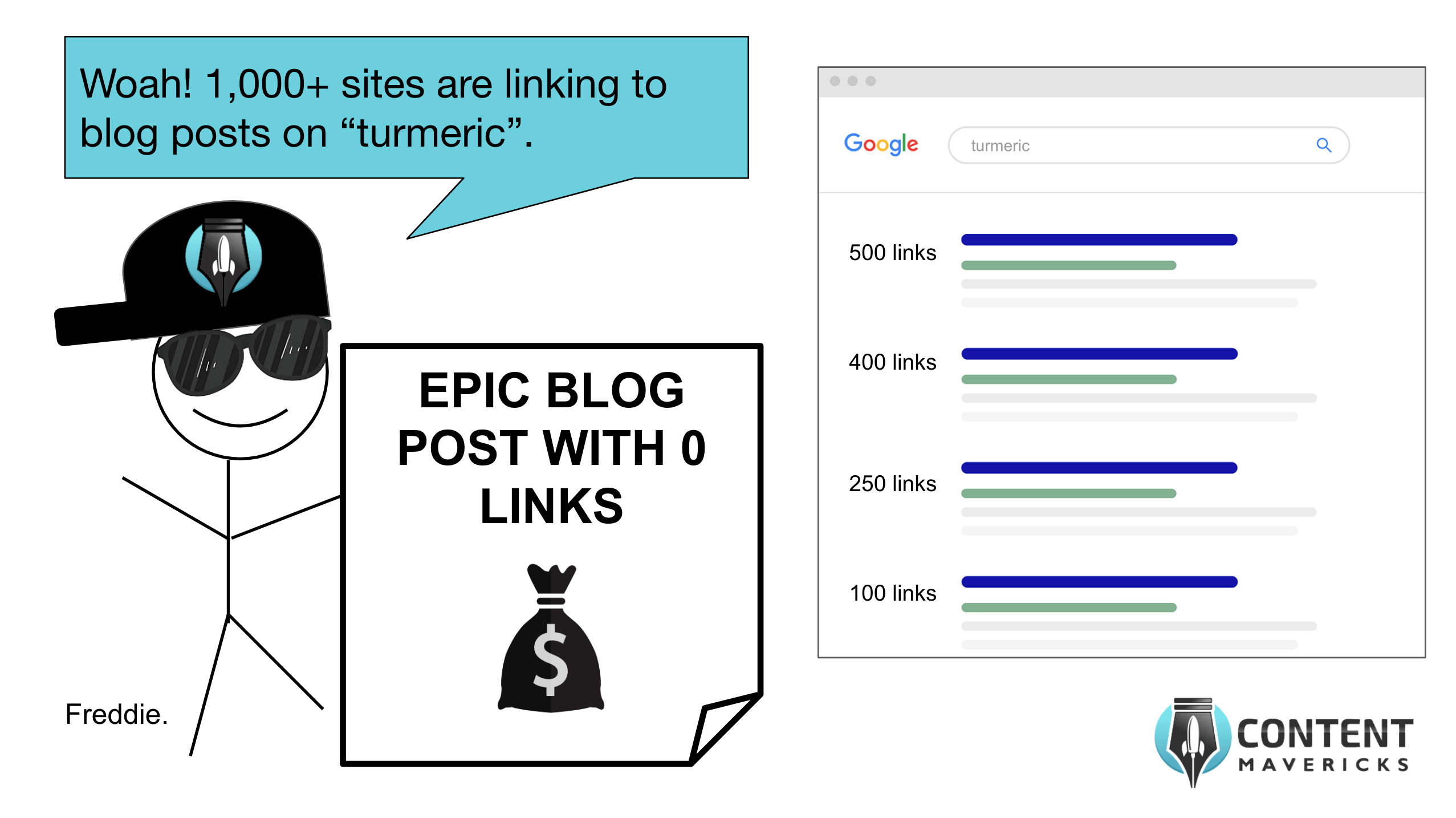
Basically, all you have to do is write one EPIC blog post (on one insanely competitive topic that has 1,000+ domains linking to other blog posts on page one of Google) then ask people to link to it.
We Used The Linkable Asset Strategy To Get 120 High Quality Links, 7X Organic Traffic, And Turn That Traffic Into $1,433,458 Of Sales Pipeline In 12 Months
The truth is:
So many businesses right now are on the verge of rocketship growth.
They have:
- A great website.
- High-quality content.
But they have zero authority, and don’t know how to build it.
Building the domain authority of your website to grow organic traffic is one of the most economical and sustainable ways to grow any business.
The reason:
Lifting the domain authority of your entire site, lifts the ranking and organic traffic of EVERY page on your site.
That's how my team was able to increase year-over-year organic traffic to a software company's site by 706.42% with 4 blog posts.
Note: Before we applied our content distribution method, organic traffic to the site hadn't increased for 5 years. And the software company's monthly recurring revenue wasn't growing unless sales reps sent cold emails to book calls and close deals.
First, we transformed the site’s backlink profile by building 10 high quality links per month over 12 months, to 4 blog posts.

Then, because we built links the right way, organic traffic followed.

This organic traffic then turned into $1,433,458 of new sales pipeline for this client.

What's important to note, is that this was done over the course of 12 months.
If we stopped building domain authority after three months, these results would never have eventuated.
So if you have high-quality content, plan to be in business for the long haul, and care about building an actual brand this strategy will be perfect for you.
The 3-Steps To Using The “Linkable Asset” Strategy To Scale Organic Traffic To Your Site
There are three steps to scale your organic traffic using this strategy.
Step 1: Find One "Linkable Asset" With 1,000+ Page One Linking Root Domains
Step 2: Get Links To Your Linkable Asset
Step 3: Scale Your Link Acquisition With An Organic Content Distribution Team
Below is a breakdown on how to do every step. But first let me tell you why this works.
If you’ve ever tried to rank a blog post on Google you’d probably know that unless your content matches the “search intent” for the topic, it won’t rank.
For example, if you try to write anything else besides a list post for the topic “increase website traffic” it will be very hard to rank.
This isn’t conjecture or theory. A quick look at page one of the Google search engine results page (SERP) for the topic will show you the intent of people searching:

This same concept of intent also applies to links and increasing the domain authority of your site so every page on your site ranks higher.
If the topic of your content doesn’t have “link intent” (i.e. lots of sites link to content on the topic), it will be very hard for you to build links and scale your organic traffic.
Even worse:
If the topic doesn’t have link intent, even if you rank #1 for the topic, people won’t passively link to your content.
For example, take a look at the link velocity for this topic. After building 20 links to the post, the content basically got no passive increase in links over two years.

Compare that to the link velocity for this topic, that got a steady, passive increase of 200 links over one year.
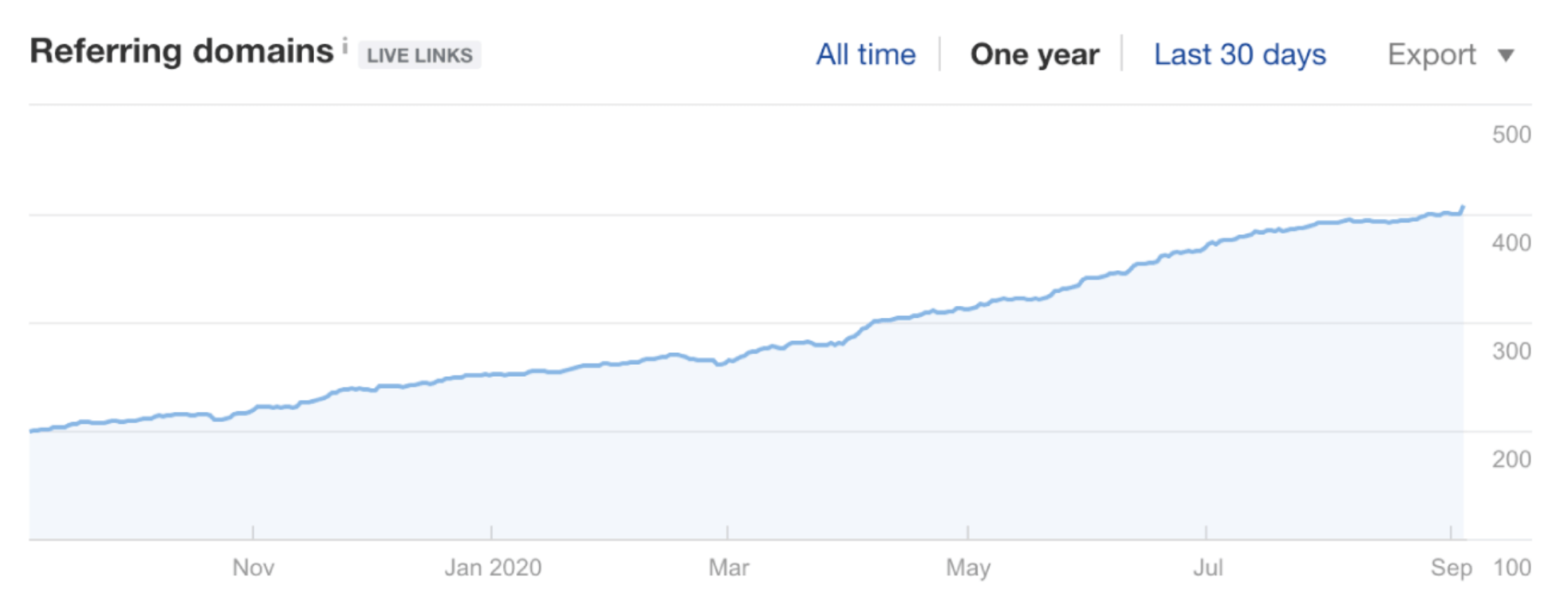
This is the difference between a marketer who thinks they’re doing SEO right because they’re ranking #1 for their target keyword vs a brand that leverages organic search to drive millions in revenue.
Increasing organic traffic at scale isn’t about writing the best content on a topic, then following tactics like broken link building, guest posting, creating and promoting infographics and doing link swaps with other site owners.
First, you need to find a blog post topic with link intent. From our experience, we’ve found the best topics to transform site-wide organic traffic levels at scale are topics with 1,000+ page one linking root domains.
Bonus: I put together a swipe file of linkable assets we promoted to increase organic traffic to our client’s site and add over $1,000,000 sales pipeline in 12 months. You can access it for free inside this Linkable Asset Swipe File.
Step 1: Find One "Linkable Asset" With 1,000+ Page One Linking Root Domains
When first starting an organic traffic campaign, most SEOs will tell you to write about keywords/topics that have a low competition, so you have a better chance of ranking.
This is the complete opposite of what we do.
Before we promote any single piece of content, we look for one thing:
The topic is INSANELY competitive.
Basically, your site will have very, very little chance of ever ranking #1 for the topic... but the topic will have over 1,000+ other sites that link to the top resources on the topic.
Why?
Our primary purpose here isn’t to rank the linkable asset; at least not in the short term.
The goal is to simply make sure there is plenty of ‘link opportunity’ for the content.
Think of linkable assets like ‘loss leaders’.
You put them out there to get noticed, get links and get people to your website looking at your main services.
Now:
Here's how to find content on your site with lots of ‘link opportunity’:
- Search your domain on Ubersuggest.
- Click on Competitive Analysis > Keywords by Traffic.
- Export the list.
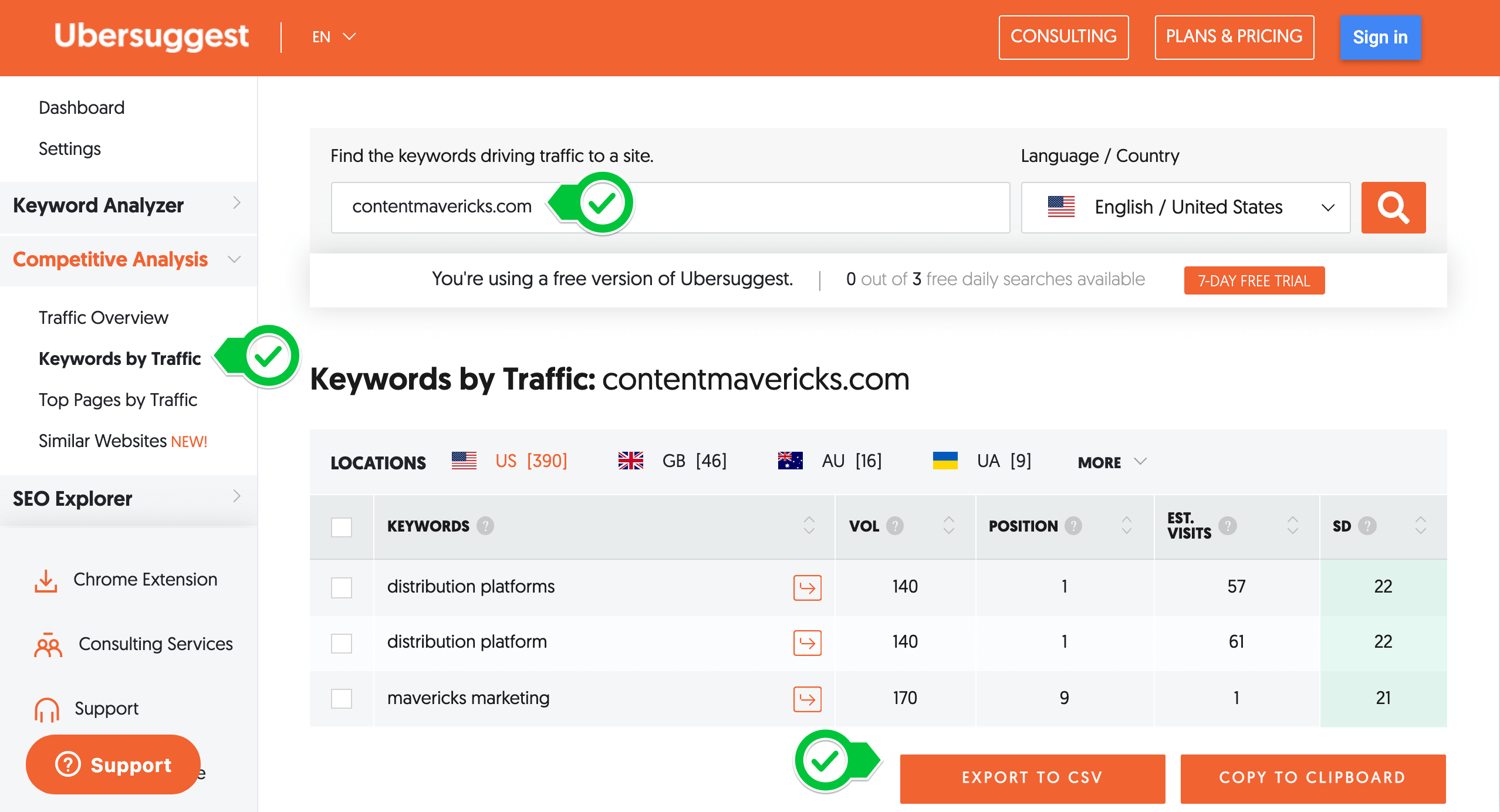
4. Remove every column except for Keyword, Keyword Difficulty and URL.
5. Order the keywords in your list by Keyword Difficulty, highest first.

6. Look at the URLs for the top keywords on your list and ask yourself:
1) Is this an evergreen topic (i.e. NOT a list of outdated strategies from 2020)?
2) Is this piece of content in-depth and one of the best pieces of content out there on this topic?
3) Is it interesting?
Keep looking through that list until you can answer ‘Yes’ to these 3 questions.
And if you answer ‘No’ to the 2nd or 3rd question, that’s easily fixable by your content team or yourself.
7. Go to SEMrush > Keyword Overview (or Ahrefs > SERP overview) and check the topic of your post has over 1,000 page one linking root domains.
For example, the topic “editorial calendar tools” has 1,328 domains linking to blog posts in positions 1-10 on the first page of Google.

And take a look at this result for the topic “turmeric”:

Page one of Google alone has nearly 10,000 individual websites linking to blog posts about Turmeric.
If you created the most insanely valuable resource about Turmeric and were only able to convince 1% of those 10,000 people to also link to yours, you’ve still built 100 links.
Not bad.
Our team would be pretty upset if we could only manage 1%.
A typical rate could be 10% or more.
Bonus: I put together a swipe file of linkable assets we promoted to increase organic traffic to our client’s site and add over $1,000,000 sales pipeline in 12 months. You can access it for free inside this Linkable Asset Swipe File.
Now let’s go over how to get 10% or more links using our method.
Step 2: Get Links To Your Linkable Asset
This is where the magic happens.
If all you did was create an insanely valuable blog post, then do nothing to promote it... you will be sadly disappointed with little-to-no traffic or sales results.
Sure, you can do what most people do:
Send it to your email list and share it on social media... you'll get a big traffic spike, but after a day or two it'll just be another piece of content gathering virtual dust on your blog.
Ongoing promotion is vital to get your content found by the right people who run solid websites (especially if you don't have a big audience yet).
First up, we need to identify who might be interested in mentioning (and linking to) your content.
That might sound simple, but there’s lots to do.
At a high-level there are 5-steps:
Step 1: Make sure their website is good, and not spammy
Step 2: Identify the right people at the site
Step 3: Find their contact details
Step 4: Pitch them in a value-led way
Step 5: Follow-up with them
Here's how to do it, step-by-step (note: our team uses some expensive proprietary tools, so I've referenced tools that are freely accessible to you).
Step 2.1: Make sure their website is good, and not spammy
Never ever do you want to get links for the sake of getting links.
If you want to get 1,000 links per day, you can use content spinners and public blog networks.
A decade ago they may have helped to improve your organic search rankings. But today they wouldn’t and they’d probably get you a sweet Google penalty.
So for every prospect we even consider reaching out to, we go through a rigorous filtering process.
After exporting a list of all the sites that link to the top 10 pages for our linkable asset’s topic, we filter based on a set of minimum metrics:
- Moz Domain Authority: 15-65
- Moz Homepage Rank: 1-7
- Moz Spam Score: 0-17

This weeds out sites on the spammier end of the scale.
Once we've filtered the list of prospects, we eyeball every single website to check for four things:
- It's not a multi-niche site (e.g. the site covers every niche you can think of and has them all in the main navigation - business, travel, CBD, tech etc).
- There are no obvious paid links (e.g. posts with lots of very exact anchor text outgoing links).
- There is no overly obvious "write for us" or "sponsored links" page (e.g. in the main header)
- It generally looks like a legit site, and is active.
Doing all of these checks makes sure we're not getting links that could hurt the authority of the site and get slapped with a Google penalty.
Step 2.2: Identify the right people at the site
Using a tool called Clearbit Connect, we can usually find anyone at any website in under 30 seconds.
We simply enter the company domain into Clearbit Connect to bring up a list of the available contacts at the site.
We then filter by job title using the term "content" or "marketing" to find the best contact in charge of content marketing on the site.

Step 2.3: Find their contact details
After identifying the right person via Clearbit Connect, we simply click on the person's name to bring up their email address and social profiles.
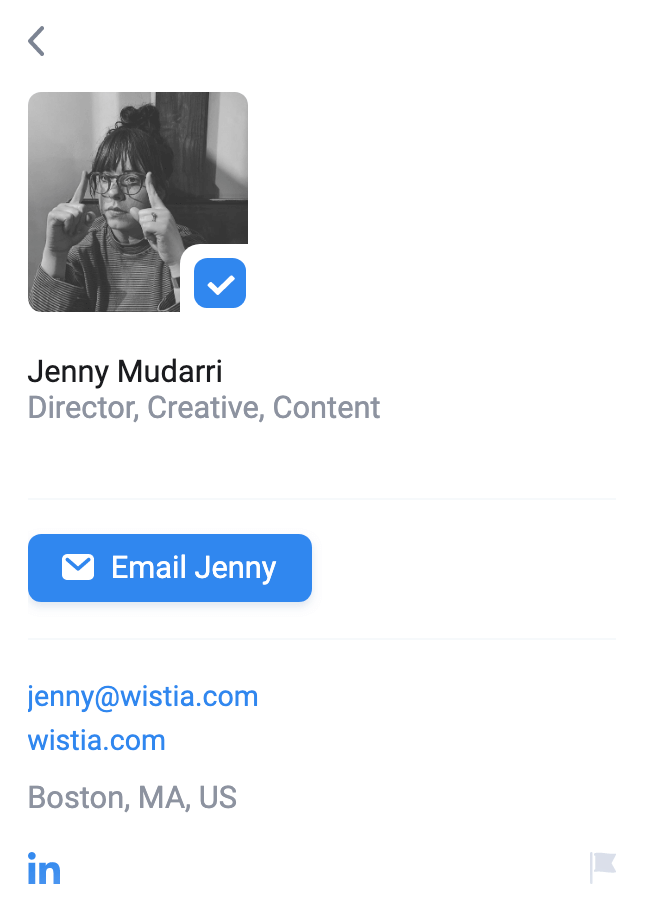
We've found this process more effective than checking WHOIS lookups, Twitter Advanced Search, LinkedIn Sales Navigator or using an email permutator to systematically generate dozens of best guess email variations.
Done on any kind of useful scale, we found these other methods to be too expensive, time-consuming, and inaccurate.
The only time we use these other methods is when Clearbit Connect does not have the site's domain or the job title of the right person we need to connect with stored in it's database.
Step 2.4: Pitch them in a value-led way
Mass sending of the exact same templated email that everyone else is doing just doesn’t cut it these days.
Every single email we send is personalized for the recipient.
For example, here one of my team reached out to a site owner on my behalf with a personalized link to the site owner's content before making the pitch:

It's little personalized touches like this that lead to responses and high quality link placements.
Step 2.5: Follow-up with them
Over 40% of our successful link placements come from followup emails.
Rather than a standard "did you get my last email?" followup, we increasingly add more value each time we get in touch with someone.
For example, above I showed you an example of a personalized email we sent.
In that example, the content manager didn't reply right away.
So we sent this followup email:

The content manager (Walter) replied with a request for us to write a guest post:

Because guest post links aren't as valuable as editorially gained links on older, established blog posts with a higher URL rating, we sent back this response:

This resulted in the content manager adding a link to our content on his blog post:

As you can see... the process for getting one link from an industry relevant, genuine, REAL website is relatively simply... but...
Doing it at scale AND authentically is not only very difficult, but a huge time drain.
That's why I don't do this myself. I have a team that does it.
Bonus: I put together a swipe file of linkable assets we promoted to increase organic traffic to our client’s site and add over $1,000,000 sales pipeline in 12 months. You can access it for free inside this Linkable Asset Swipe File.
Now let’s go over how to scale this process with a team.
Step 3: Scale Your Link Acquisition With An Organic Content Distribution Team
As you saw, it’s a simple process to get one link to one blog post, but doing it at scale AND authentically can be difficult, mainly due to how time consuming personalized email outreach can be at scale.
To be honest:
I avoided scaling organic traffic for my own sites and client sites for a looooong time because of this exact reason.
When I think of "fun", link building def isn't at the top of my list.
Break dancing is fun. Going to the movies with my wife is fun. Sending emails to get links for my site is NOT fun.
It was only when a client came by that wanted to get more out of their current content, without having to create any new content or spend any money on ads that I developed this strategy with my team.
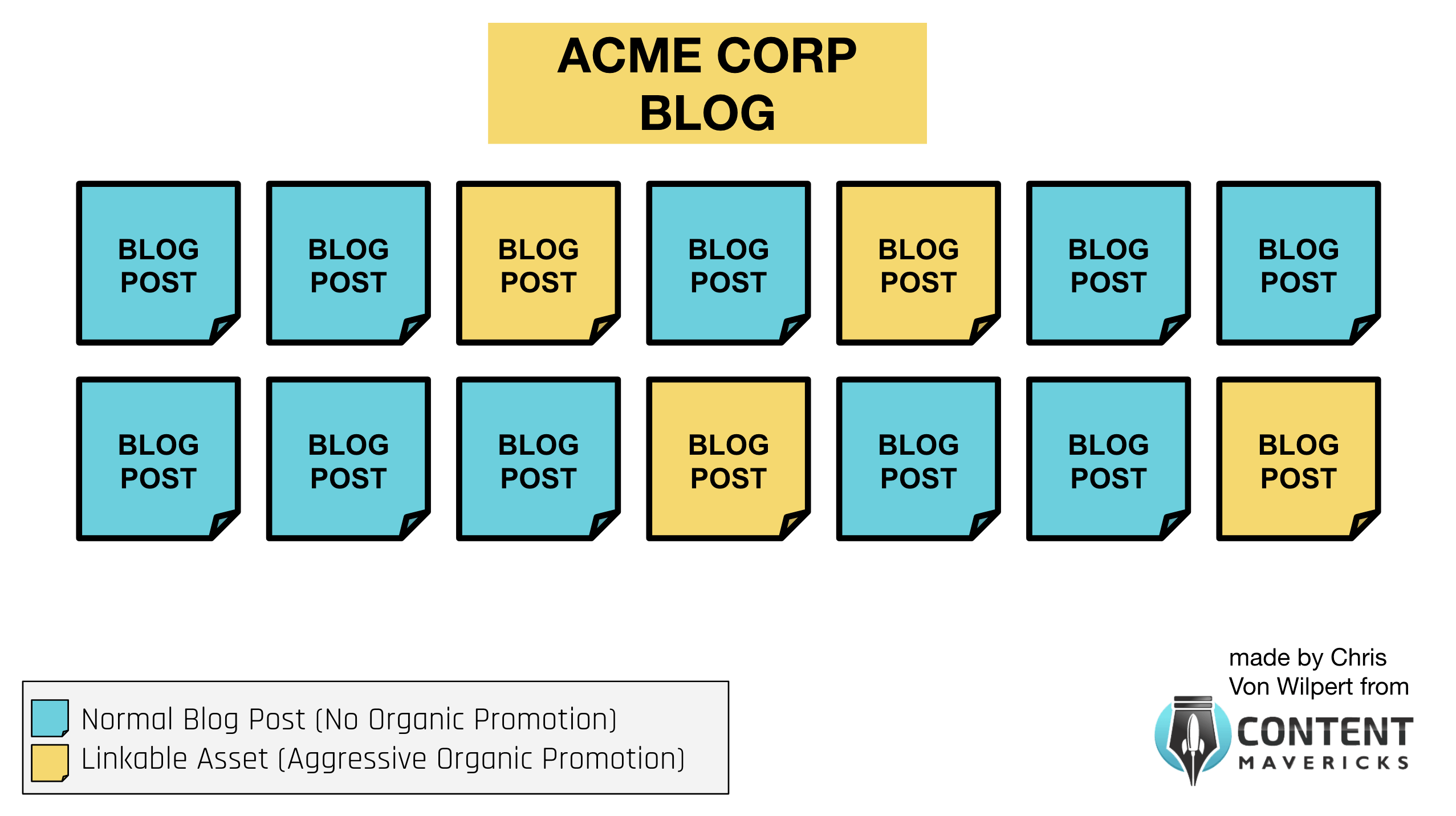
For this client we:
- Built an average of 10 links per month over a 12 month period, to 4 different linkable assets.
- The average domain authority (DA) was 38.6.
- The highest DA was 92.
- 11 links were over DA 70+.
All links were from industry relevant, genuine, REAL websites that were pleased to hear about the content.
These are the kinds of links that move the needle.
The most interesting part:
Not all of the content we built links to now ranks #1 on Google.
Some of it ranks well now, and actually drives relevant traffic that converts... but...
Ranking #1 for a single topic is not the primary focus.
When ranking #1 is your primary focus (like most SEO agencies) it is very, very hard to get results because your "upside potential" is always limited by the traffic potential of individual content topics.
If something gets searched for 1,000 times per month, you rank #1, and the click-through rate on Google for the #1 listing is 30%...
The most amount of traffic you will get is 333 visitors per month.
Our new strategy uses linkable assets with high link intent (1,000+ page one linking root domains) to transform site-wide organic traffic levels, and increase traffic across the board from the top to the bottom of the funnel.

This is key when driving organic traffic that turns into sales (vs purely top-of-funnel traffic that converts at lower rates)... because...
You're creating new interest at every buying stage.
Now:
If you've got one or more linkable assets that are evergreen, in-depth and interesting... after going through the process above…
But you don’t have the time and energy to filter through 1,000+ sites, find the right contact information, and do all the personalized outreach at scale.
I want to invite you to hire my content distribution team.
My content distribution team can take content that’s sitting on your site doing nothing, and start promoting it FOR YOU day-in-day-out so you can scale your traffic, rankings and revenue while your competition sleeps.
P.S. Historically, we see a 2x-7x increase in organic traffic over 12 months following this strategy.


